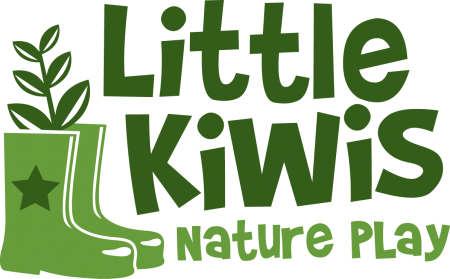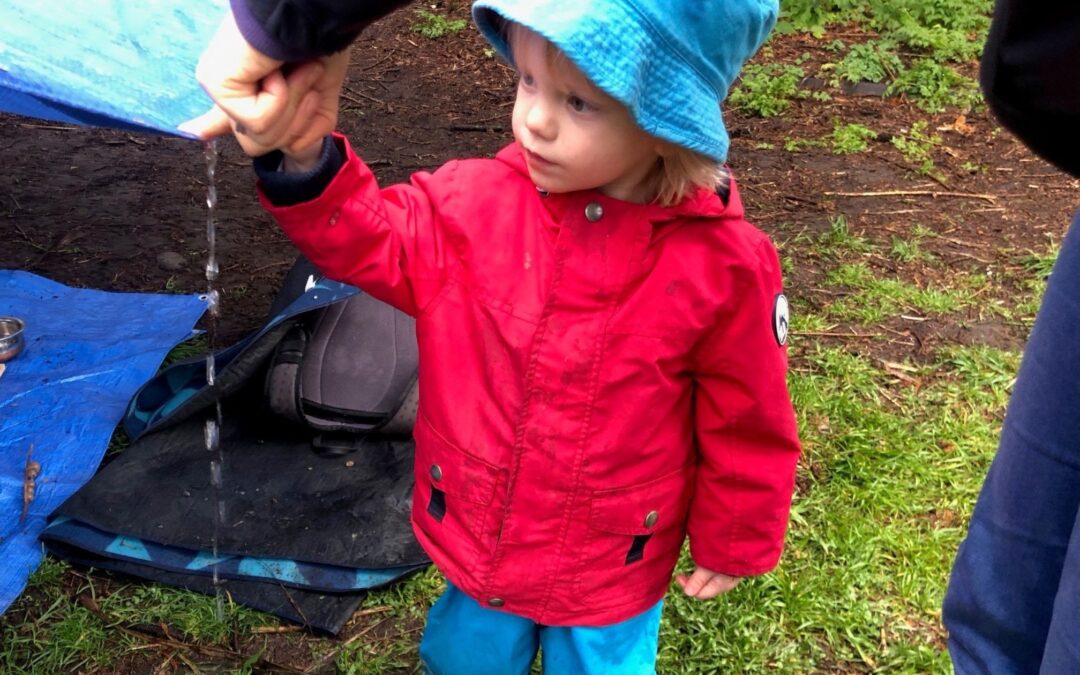Rain, rain go away, come again another day! Do you remember singing that as a child? Maybe I am showing my age, but I use to love singing that while playing in the rain.
Yet so often I hear people say ‘it’s too wet to go outside’.
There’s this great saying; ‘I have never met a child who got so wet that they couldn’t get dry again’.
What is it about the rain and the cold, that makes adults want to stop children going outside? Because for most children if they are dressed appropriately i.e. they are warm enough, they will happily play outdoors in the cold and wet.
The real problem is adults.
You heard me right – it’s us!
When I explore this with teachers and parents what often comes out is that the adults don’t want to get wet and or, the adults don’t want to get cold.
It is either our own discomfort or a perceived discomfort of being outdoors when it’s wet and cold, that often makes the decision. This can either be for us or out of concern for our children.
Another common reason why children aren’t allowed to play outside in the rain is the thinking that they might get sick from being outside in the cold.
Professor Raina MacIntyre, (Professor of Infectious Diseases Epidemiology and Head of the School of Public Health and Community Medicine at the University of New South Wales) suggests that, ‘exposure to cold weather will not give you a cold because colds are caused by viruses. There is an association between cold weather and the winter season, and common colds because transmission of cold viruses is much higher in cold weather. It’s likely that colds and influenza outbreaks peak in winter because we tend to huddle together in small, often stuffy, unventilated spaces. It’s also unlikely that exposure to cold weather will exacerbate the symptoms of a cold’.
If we are going to challenge our thinking around children playing in the wet and cold, then we need to know what some of the benefits of playing outdoors in all types of weather are.
This will help us to challenge that mindset and hopefully start to see rain and cold weather as an opportunity rather than something to avoid. We can also ask ourselves if there are other barriers in the way of getting outdoors in all weather and what we can do to remove them.
BENEFITS OF OUTDOOR PLAY
Physical Health
When children have regular time outdoors, including forests, parks, and playgrounds, they have opportunities to release stress, play vigorously, and directly explore nature, which in turn provides physical and psychological benefits (Frost, Physical Health and Motor Development 2010; Jacobi-Vessels, 2013; Louv, 2005).
In nature, exposure to germs for your child’s developing immune system is of great advantage. Microbial exposure and increased microbial burden is beneficial for wellness. (Gilbert, J. Knight, R. 2017)
Mental Health
Having just 20 minutes outdoors helps us to regulate our emotions by significantly reducing our cortisol levels. (Mary Carol R. Hunter, Brenda W. Gillespie, Sophie Yu-Pu Chen, 2019)
Having regular contact with natural outdoor environments plays a pivotal role in promoting children’s health and wellbeing. (Armitage, 2009; Jacobi-Vessels, 2013; Kernan & Devine, 2010; Louv, 2005; Robinson & Wadsworth, 2010)
Managing Themselves and Risky Play
When playing outdoors children are presented with many situations where they need to manage themselves and the risks they take. When it’s cold and wet they also develop awareness around what clothing they need to have on in different scenarios. Risky play helps children to learn to manage their own safety and move around comfortably (Knight, 2009).
Enhanced Creativity
Play in nature is especially important for developing capacities for creativity, problem solving and intellectual development (Kellert, 2005). There is freedom in nature that comes without scripts and allows for imagination in very special ways.
Connection with Nature
Research has shown that empathy with and love of nature grows out of children’s regular contact with the natural world. Hands-on, informal, self-initiated exploration and discovery in local, familiar environments are often described as the best ways to engage and inspire children and cultivate a sense of wonder. These frequent, unstructured experiences in nature are the most common influence on the development of lifelong conservation values. (DOC, 2011)
Sensory Input
Rain is a unique sensory experience. Getting sensory input in all types of weather not only helps strengthen neural pathways in the brain, but it also helps us to learn that it can be an enjoyable experience and shouldn’t be avoided thus promoting a healthy lifestyle.
It’s also good to recognise that for some children on a rainy day, if they are kept inside it can become a sensory overload so there are real benefits around self-regulation on raining days for children to be able to go outside.
Jean Ayres initially developed an understanding sensory integration theory and suggests that when multiple senses are utilised together it creates more connections in the brain leading to improved sensory processing, regulation, and learning.
Resilience
Resilience is the ability to bounce back from challenges or difficulties. Some might say that going outside in the rain is a challenge. By providing opportunities for children to experience little challenges along the way, we help them to build up a foundation of knowledge about themselves and what they are capable of. So when they are faced with future challenges they have knowledge and skills they can call upon.
Some research from Chawla suggests that children experience peace, calm, and relaxation in their green schoolyards and gardens, but they also experienced opportunities to feel competent and opportunities for the development of supportive social relationships, which are important protective factors for resilience (Chawla, et al., 2014).
Nature is the Teacher
Nature is a science lab! And when it rains there are so many different things to observe and learn about. Water sustains life and supports all eco-systems AND it can magically disappear – where does it go? What does it taste like? How heavy is it? There is so much to learn about rain and water but to really know about it, it has to be experienced. Remember too, that there is much more to nature than rain – it doesn’t stop there!
Outdoor Play Every Day is great for our children’s overall health and well-being. It helps them develop into capable, confident humans and gives them a variety of skills to help them navigate on their journey through life.
When it comes to the weather and play, it doesn’t matter if it’s sunny or raining, the benefits are still the same. There is no discimination.
Remember ‘There is no such thing as bad weather, just bad clothing’.
So next time it’s raining, remind yourself of some of these benefits, dress for the weather, Take Them Outside and Let Them Play!
Celia Hogan
REFERENCES
- Frost, J. L. (2010). A history of children’s play and play environments: Toward a contemporary childsaving movement. New York, NY: Routledge.
- Louv, R. (2005). Last child in the woods: Saving our children from nature-deficit disorder. Chapel Hill, N.C: Algonquin Books of Chapel Hill.
- Gilbert, J. Knight, R. 2017. Dirt is Good, The Advantage of Germs for your Child’s Developing Immune System.
- Mary Carol R. Hunter, Brenda W. Gillespie, Sophie Yu-Pu Chen. (2019) Urban Nature Experiences Reduce Stress in the Context of Daily Life Based on Salivary Biomarkers
- Armitage, K. (2009). The nature study movement: The forgotten popularizer of America’s conservation ethic. Lawrence, KS: University Press of Kansas.
- Jacobi-Vessels, J. L. (2013). Discovering nature: The benefits of teaching outside of classroom. Dimensions of Early Childhood, 41(3), 4-9.’
- Kernan, M., & Devine, D. (2010). Being confined within? Constructions of the good childhood and outdoor play in early childhood education and care settings in Ireland. Children & Society, 24, 371-385. doi: 10.1111/j.1099-0860.2009.00249.x
- Robinson, L. E., & Wadsworth, D. D. (2010). Stepping toward physical activity requirements: Integrating pedometers into early childhood settings. Early Childhood Education Journal, 38, 95-102. doi 10.1007/s10643-010-0388-y
- Knight, S (2009). Forest schools and outdoor learning in the early years. London, SAGE publications.
- Kellert S, R. (2005). Building for life: Designing and understanding the human-nature connection. Washington, DC: Island Press.
- DOC 2011, Benefits of connecting children with nature, Wellington, New Zealand, https://www.doc.govt.nz/Documents/getting-involved/students-and-teachers/benefits-of-connecting-children-with-nature.pdf
- Chawla, L., Keena, K., Pevec, I., & Stanley, E. (2014). Green schoolyards as havens from stress and resources for resilience in childhood and adolescence.
Not sure what to wear? Look out for our next article on what to wear during winter.
WANT A FREE 5 PAGE SUMMARY OF RESEARCH? CLICK HERE.


Thank you for this awesome report, I run a school age program in Canada and we struggle every year to get the parents invested in Our outdoor play policy and rain/snow I would absolutely love to use your website as reference point for our parents.